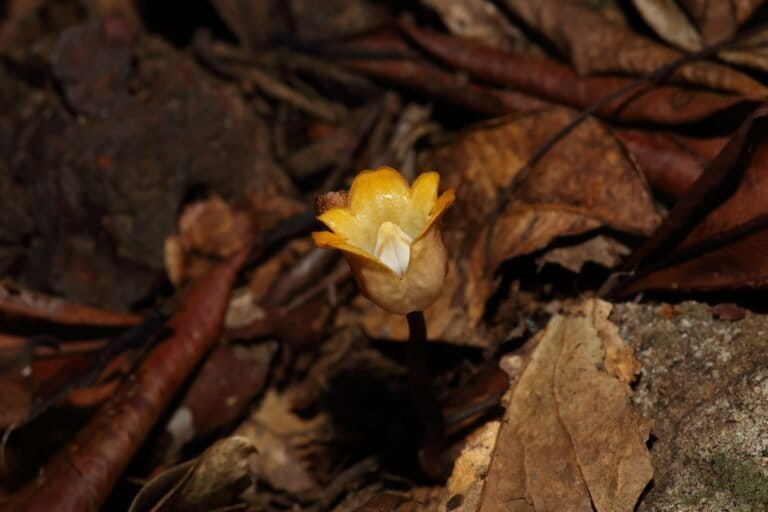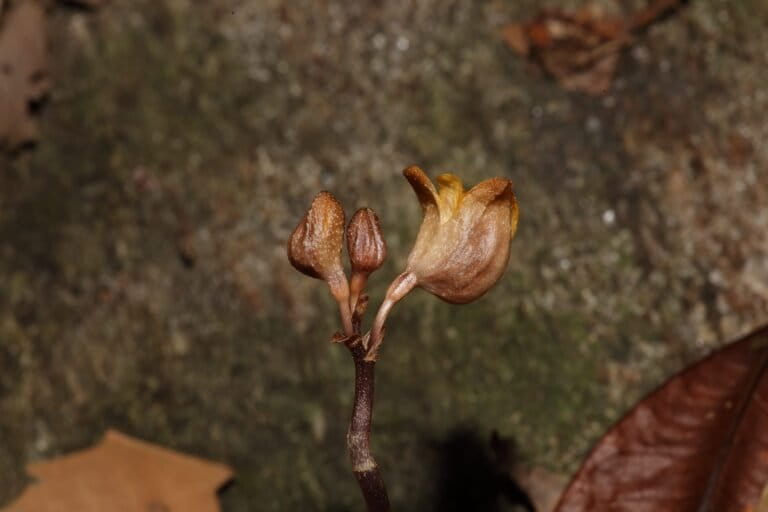- A new leafless ground orchid found in a lowland wet zone forest in Sri Lanka has been named after a precious yellow sapphire as Gastrodia pushparaga, a gemstone commonly extracted from the same district.
- This is the third Gastrodia species found in Sri Lanka, after the 1906 identification of G. zeylanica and G. gunatillekeorum, described in 2020, 114 years later.
- The plant grows in Walankanda, a forest frontier in the island’s intermediate zone with unique characteristics that will likely make these plants susceptible to future climate change impacts earlier than other wet zone rainforest plants.
- Tea plantations being the main prompt for forest fragmentation in the area, an ambitious project aims to create an ecological land corridor through neglected tea estates, linking the forest where the orchid was first found with another fragmented forest patch.
COLOMBO — The Sinharaja Biosphere Reserve and UNESCO World Heritage Site is a large complex of lowland wilderness that is largely fragmented due to human activity. Walankanda and Viharakanda are two fragmented forest areas, and an ongoing project aims to connect these two forest areas through a land corridor. Amila Perera, the project’s coordinator from Dilmah Conservation, was undertaking a survey on plants for this project when he made a chance observance of an unusual flower in the Walankanda forest floor.
The flower was yellow with a red tint; what was unusual about the plant was that it had no leaves. Perera recalled a somewhat similar wildflower belonging to the ginger family, but he thought this was a different bloom. To verify, in March 2021, he sent a photograph of the flower to Bhathiya Gopallawa, a PhD candidate at the University of Peradeniya (UOP) who worked at the National Herbarium.

The characteristics of a flower are critical for plant identification, so there are instances in which botanists must wait years or even decades until a tree begins to flower in order to make an accurate scientific identification. But in this instance, the orchid did not have any leaves and the only identifier was the flower itself. Also, similar orchids in the area had shed flowers and already had seed pots, giving a clear sign that their flowering season was reaching its end.
Without wasting time, Gopallawa secured a permit from the Forest Department to collect the orchid and rushed to Walankanda within three days of getting the photo.
Inspecting the flower thoroughly, Gopallawa felt it could be a ground orchid belonging to the genus Gastrodia, a group of terrestrial leafless orchids from the family Orchidaceae, having over 90 members globally. The orchids in this genus have fleshy, underground rhizomes, so they are also referred to as “potato” orchids. The first Gastrodia orchid found in Sri Lanka was G. zeylanica, described way back in 1906, and the second, G. gunatillekeorum, identified in 2020, after 114 years since the identification of the first Gastrodia.

Gopallawa and the team reached out to global and regional orchid experts to compare the flower they collected from Walankanda. It closely resembled the Taiwanese endemic orchid, G. sui, but was identified as being unique to Sri Lanka. The new species study was published in mid-March, elevating this orchid as the third Gastrodia from Sri Lanka, with all three of them being endemic to the Indian Ocean island. The new orchid will be known as Gastrodia pushparaga, named after the local yellow sapphire gem commonly found in gem pits of Ratnapura in Sabaragamuwa province, where the orchid was also found.
“The flower’s hue is like that of the sparkling yellow sapphire. A high-quality yellow sapphire has a red tint, similar to this orchid variety,” Gopallawa said.

Later, two more populations of G. pushparaga were recorded from the Ratnapura district, one from Walankanda and another from Kalawana. The orchid was also found in three other sites between February and April 2022 during a study in the adjacent Sinharaja reserve.
According to the surveys, G. pushparaga‘s flowering season is about a month, from March to April, while fruiting can be found from April through June. After the flower has fallen, the stem grows farther up, which may be an adaptation to spread the seeds in a larger area, Gopallawa told Mongabay.

Biodiversity in fragmented forests
The orchid grows in dense leaf litter enriched with decaying plant material, in the shady areas of the mixed dipterocarp-dominated forests. Assessing the distribution and the threats, the researchers categorized the plant as vulnerable.
When the British cleared the wetland and highland forests to plant tea in Sri Lanka, they had done plant surveys that led to the identification of many species like G. zeylanica. However, this followed a period of inactivity; but now there is a resurrection of plant studies due to the accessibility to the sites and the enthusiasm of young botanists who undertake regular field surveys and use technology to share information, Nimal Gunatilleke, UOP emeritus professor, told Mongabay.
Gunathilake conducted landmark research on Sinharaja with his wife, Savitri Gunatilleke, who is also an emeritus professor of forest ecology. The second species of Gastrodia orchid discovered in 2020 is named after the Gunatillekes.

Orchids are sensitive to ecological changes, so good environmental indicators are a must, Gunatilleke said. Walankanda is unique, as it is a frontier to the intermediate zone, hence impacts of climate change may first impact such forests before other forests such as the Sinharaja, which is located at the center of the wet zone. “Studying orchid species like G. pushparaga in the long term may yield some interesting findings,” Gunatilleke told Mongabay.

Besides, fragmented forest patches in the lowland wet zone like Walankanda are important biodiversity hotspots, said Gunatilleke. As the animals and plants are restricted to the area, their gene pool shrinks, and inbreeding can further weaken their gene pool, which makes it even more important to link the fragmented forest patches, Gunatilleke added.
Historically, clearing forests for tea plantations has been the main reason for forest fragmentation in most places. Trying to link Walankanda with another fragmented forest patch named Vihara Kanda is an ambitious project initiated under the guidance of Gunatilleke at Endana tea estate, with the support of Dilmah Conservation. Under this, a nature corridor of about 1.5 kilometers (just under 1 mile) will be set up through ecological restoration.

According to the National Conservation Review of Sri Lanka, in 1997, the Delwala Kanda and Walankanda region were among 13 other fragmented forest territories that were located close to the Sinharaja rainforest. The identification of the new orchid now highlights the importance of these forest patches and the need to link them back together, creating a larger forest complex.
Citation:
Gopallawa, B., Perera, A., Madola, I., Yakandawala, D., Kumar, P., Jayawickrama, H., Chase, M. W., (2023). Gastrodia pushparaga (Orchidaceae, Epidendroideae, Gastrodieae), a new species from Sri Lanka. Phytotaxa, 587(2): 193-199. DOI:10.11646/phytotaxa.587.2.8
Yeh, C., Leou, C., Hsu, T., & Yeh, C. (2011). Gastrodia Sui Sp. Nov. (Orchidaceae) from Taiwan. Nordic Journal of Botany, 29(4), 417-419. doi:10.1111/j.1756-1051.2011.01147.x
UCN, W. (1997). Designing an optimum protected areas system for Sri Lanka’s natural forests. Volume 1. Retrieved from http://www.rainforestprotectors.org/rainforest/knowledgebank/National%20Conservation%20Review.pdf
Banner image: The newly discovered Gastrodia pushparaga, an orchid growing in shady leaf litter in dipterocarp forests in Sri Lanka’s wet zone, courtesy of Amila Perera.
See also by this reporter:
Updated red list raises red flags for Sri Lanka’s birds, especially endemics
